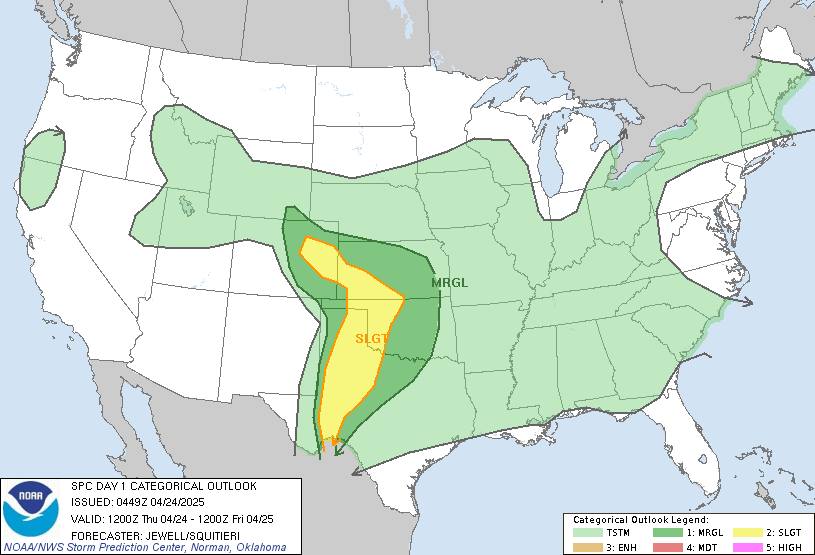LIVE MAP (ABOVE) ... SPC 1200Z Day 1 Outlook
Day 1 Convective Outlook
NWS Storm Prediction Center Norman OK
1200 AM CST Mon Mar 03 2025
Valid 031200Z - 041200Z
...THERE IS A SLIGHT RISK OF SEVERE THUNDERSTORMS ACROSS PORTIONS OF
CENTRAL OKLAHOMA INTO NORTHERN TEXAS...
...SUMMARY...
Thunderstorms should increase this evening and merge into a squall
line tonight across portions of the southern Plains. Severe gusts,
hail, and a few tornadoes are possible with the stronger storms.
...Synopsis...
A pronounced mid-level trough will traverse the southern Rockies
today and eject into the Southern Plains tonight, encouraging rapid
development and deepening of a surface low over the central Plains
through the period. During the day and especially evening hours, a
strong southerly low-level jet will develop across the southern and
central Plains as an 80-100 kt 500 mb jet streak pivots around the
mid-level trough and overspreads the low-level jet axis. At the same
time, modified boundary-layer moisture will advect northward,
promoting marginal instability across the warm sector ahead of the
surface low. The net result will be increasing deep-layer ascent,
supporting thunderstorm development amid strong unidirectional shear
profiles. A squall line should develop later tonight and promote
severe potential, with all severe hazards possible.
...Central and southern Plains this evening into tonight...
A southerly 850 mb jet increases to well over 50 kts after sunset,
overspread by at least 80 kts of southerly 500 mb flow, contributing
to over 50 kts of effective bulk shear. A surface cold front will
surge eastward after 00Z across western OK/TX, supporting
thunderstorm development. While supercell structures may develop
initially, rapid upscale growth is expected given linear forcing
(e.g. unidirectional vertical wind profiles above the boundary
layer). The best chance for large hail will be with the more
discrete storm structures, thereafter, severe gusts become the
primary concern with squall line development.
Overnight, low 60s F surface dewpoints will overspread much of TX
into central OK beneath 7+ C/km mid-level lapse rates as
temperatures above the boundary layer cool with the approach of the
upper trough, yielding over 1000 J/kg MLCAPE. However,
boundary-layer lapse rates appear to be poor in some deterministic
guidance, raising some concerns as to how much appreciable
surface-based buoyancy can materialize tonight. Forecast soundings
show elongated hodographs, with a noticeable degree of curvature in
the 0-3 km layer, potentially yielding up to 500 m2/s2 of effective
SRH. Such shear profiles amid marginal instability would favor a
QLCS tornado threat if said instability can become surface-based. At
the moment, confidence is not overly high in appreciable boundary
layer destabilization. However, higher severe probabilities may be
needed in later outlooks if greater boundary-layer buoyancy becomes
apparent.
..Squitieri/Goss.. 03/03/2025
Read more CHECK UPDATE ZOOM GRAPHIC
http://dlvr.it/TJHfNg
Windy.com Temps | Gusts | WU KORD KPWK |
CLICK for this month's BIG night sky ... | RADAR FULL MAP SCREEN |
|---|
MOBILE DEVICE? Turn sideways. Weather conditions directly above are near Lakefront. Top tabs refer to O'Hare (official).
Archives for the SPC Convective Outlook are updated daily (approximately) with a live map at the beginning of each article. Follow the link at the end of the article to check for current updates on the NOAA/NWS Storm Prediction Center website. Also, see Archives for Chicago's hourly weather data on CARDINAL NEWS Magazine.
CONVECTIVE | TORNADO | WIND | HAIL
O'Hare International Airport KORD
(Arlington Heights South)
Chicago Executive Airport KPWK
(Arlington Heights North)
Monday, March 3, 2025
SPC Mar 3, 2025 0600 UTC Day 1 Convective Outlook
SUNRISE AND SUNSET TIMES IN UTC (if you're not logged in to Google)
CHICAGO UTC-6 during CST (Central Standard Time, e.g., winter)
CHICAGO UTC-5 during CDT (Daylight Savings Time, e.g., summer)
CHICAGO UTC-6 during CST (Central Standard Time, e.g., winter)
CHICAGO UTC-5 during CDT (Daylight Savings Time, e.g., summer)





















